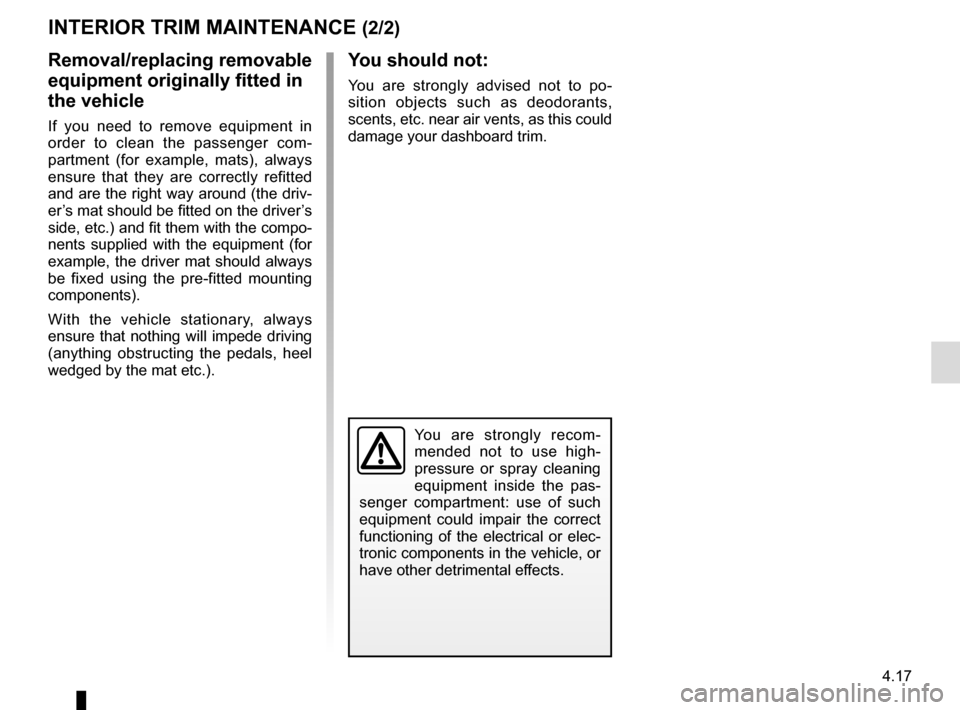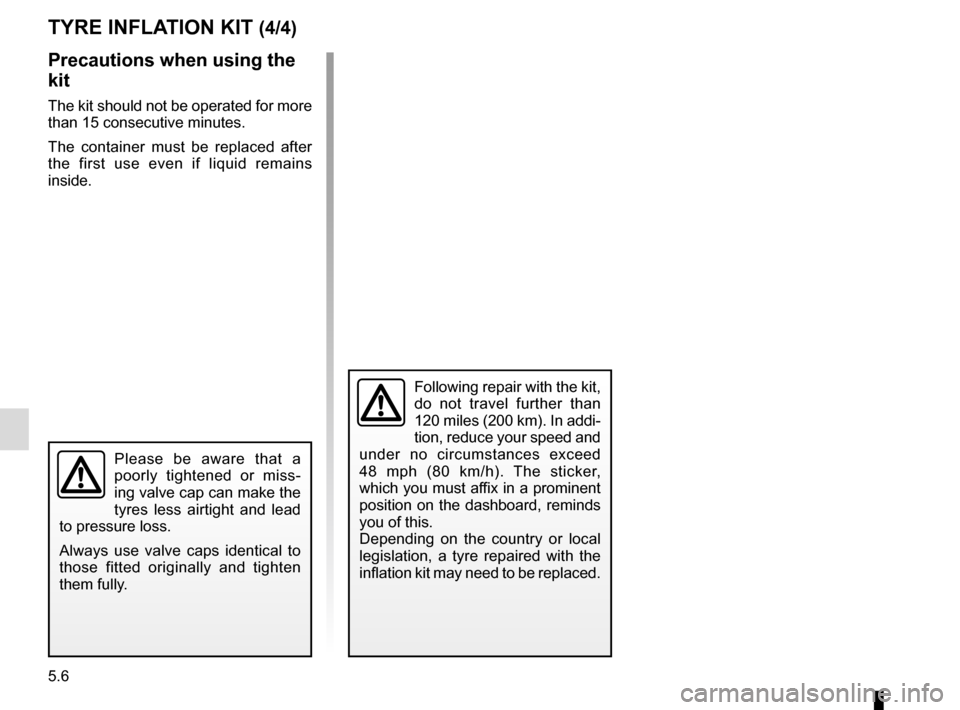2016 RENAULT TALISMAN dashboard
[x] Cancel search: dashboardPage 227 of 328

3.37
If fitted on the vehicle, the tailgate locks
and unlocks at the same time as the
doors.
Depending on the vehicle, you have se-
veral different ways to manoeuvre the
tailgate:
– using the RENAULT card remote control;
– using the controls on the tailgate;
– using the dashboard control;
– using the hands-free function.
AUTOMATIC TAILGATE (1/5)
Conditions of use
– Immobilise the vehicle.
– If there is any ice or snow prevent-ing the tailgate from opening, this ice
or snow must be removed to free the
tailgate.
– In the event that the battery is dis- charged or if it is changed, the tail-
gate should be closed (manually
if necessary) to restart the tailgate
motor.
Ensure that nobody is close
to the moving parts when
opening/closing the tail-
gate.
Risk of injury.
Opening/Closing
Activating the automatic tailgate ope-
ning or closing using the dashboard
control or using the RENAULT card
causes three beeps to sound just
before the tailgate begins to move.
When opening or closing the tail-
gate, ensure that nothing interferes
with the manoeuvre.
To avoid damaging the tailgate
system, do not manually force the
tailgate to open or close while it is
moving.
The attaching of any
carrying device (bike rack,
luggage box, etc.) resting
on the luggage compart-
ment lid is prohibited. To install a
carrying device on your vehicle,
contact an Approved Dealer.
Page 229 of 328

3.39
Do not keep your foot in the air. Carry
out the movement without stopping.
Note: With the tailgate open, after de-
tecting a closure control, it waits around
3 seconds before triggering the closure
(a beep is emitted every second).
Using the dashboard control
Press and hold switch
4.
Using the hands-free function
The hands-free function grants access
to the boot or allows it to be closed
while you have your hands full.
With the RENAULT card on your person
and with the ignition off, perform a for-
wards/backwards movement with your
foot in the area delimited by the sen-
sors 5.
The sensor detects the approach and
removal of your foot and triggers the
opening or closing of the tailgate.
AUTOMATIC TAILGATE (3/5)
Activation/deactivation of the
hands-free function
Using the multifunction screen, select
menu “Vehicle”, “User settings” then
“Use handsfree card: open/close”.
Select “ON” or “OFF” to activate or de-
activate the function.
Usage features of the hands-free
function
– the hands-free function is no longer available after a few days of lack of
movement of the vehicle, or after
around 15 minutes if the vehicle is
unlocked. To reactivate it, use the
unlocking button on the RENAULT
card.
– The “Hands-free” function is only available if the vehicle is stationary
and the engine is switched off (and
not on standby with the Stop and
Start function).
– The «hands-free» feature may not work if the vehicle is equipped with a
towbar or is in an area of high elec-
tromagnetic radiation.
5
4
Page 244 of 328

4.2
BONNET (1/2)Unlocking the bonnet catch
To unlock, push tab 3 at the same time
as opening the bonnet.
Opening the bonnet
Lift the bonnet, guiding it up, and it
will rest in position with the help of two
struts 2.
To open, pull handle
1, located on the
left-hand side of the dashboard.
The engine may be hot
when carrying out opera-
tions in close proximity. In
addition, the engine cooling
fan can come on at any moment.
Risk of injury.
1
Do not press down on the
bonnet: there is a risk that
the bonnet may accidentally
close.
Before performing any
action in the engine com-
partment, the ignition must
be switched off by pressing
the engine stop button (please see
the information on “Starting, stop-
ping the engine” in Section 2).
When working in the engine
compartment, ensure that
the windscreen wiper stalk
is in the park position.
Risk of injury.
2
3
Page 259 of 328

4.17
You should not:
You are strongly advised not to po-
sition objects such as deodorants,
scents, etc. near air vents, as this could
damage your dashboard trim.
You are strongly recom-
mended not to use high-
pressure or spray cleaning
equipment inside the pas-
senger compartment: use of such
equipment could impair the correct
functioning of the electrical or elec-
tronic components in the vehicle, or
have other detrimental effects.
INTERIOR TRIM MAINTENANCE (2/2)
Removal/replacing removable
equipment originally fitted in
the vehicle
If you need to remove equipment in
order to clean the passenger com-
partment (for example, mats), always
ensure that they are correctly refitted
and are the right way around (the driv-
er’s mat should be fitted on the driver’s
side, etc.) and fit them with the compo-
nents supplied with the equipment (for
example, the driver mat should always
be fixed using the pre-fitted mounting
components).
With the vehicle stationary, always
ensure that nothing will impede driving
(anything obstructing the pedals, heel
wedged by the mat etc.).
Page 265 of 328

5.5
TYRE INFLATION KIT (3/4)
If a minimum pressure of 1.8 bar is
not reached after 15 minutes, repair
is not possible; do not drive the ve-
hicle but contact an approved dealer.
Once the tyre is correctly inflated,
remove the kit: slowly unscrew the in-
flation end piece of the container 2 to
prevent any product spatter and store
the container in plastic packaging to
prevent product leaks.
– Affix the driving recommendation label (located under the container) to
the dashboard where the driver can
see it.
– Put the kit away.
– At the end of this initial inflation op- eration, air will still escape from the
tyre. You must drive a short distance
in order to seal the hole.
Nothing should be placed
around the driver’s feet
as such objects may slide
under the pedals during
sudden braking manoeuvres and
obstruct their use.
2– Start immediately and drive at a speed of 12.4 to 37.2 mph (20 to
60 km/h) in order to distribute the
product evenly in the tyre; after driv-
ing a distance of 1.86 miles (3 km),
stop and check the pressure.
– If the pressure is higher than 1.3 bar but lower than the recommended
pressure (refer to the label affixed to
the edge of the driver’s door), adjust
it. Otherwise, contact an approved
dealer: the tyre cannot be repaired.
Page 266 of 328

5.6
Precautions when using the
kit
The kit should not be operated for more
than 15 consecutive minutes.
The container must be replaced after
the first use even if liquid remains
inside.
TYRE INFLATION KIT (4/4)
Following repair with the kit,
do not travel further than
120 miles (200 km). In addi-
tion, reduce your speed and
under no circumstances exceed
48 mph (80 km/h). The sticker,
which you must affix in a prominent
position on the dashboard, reminds
you of this.
Depending on the country or local
legislation, a tyre repaired with the
inflation kit may need to be replaced.
Please be aware that a
poorly tightened or miss-
ing valve cap can make the
tyres less airtight and lead
to pressure loss.
Always use valve caps identical to
those fitted originally and tighten
them fully.
Page 285 of 328

5.25
FUSES (2/2)
Allocation of fuses
(the presence of certain fuses depends on the vehicle equipment level)\
Symbol Allocation SymbolAllocation
HWindscreen washerNot used
ëThird row accessories socket, boot accessories
socketÝTowbar socket
ÆFront cigarette lighter, front and rear accessories
socketDiagnostic socket, audio alarm
Not usedÌHorn
Heated door mirrorsInstrument panel, dashboard control lighting
×Brake lights, passenger compartment central unitPiloted dampened suspension
\bParking brakefFront windscreen wiper
Additional servoDDirection indicator lights, hazard warning lights
îRadio, multifunction screen, multimedia acces-
sories sockets, parking brake controlRear USB sockets on console
Passenger compartment centre unit, rear wiper,
rear fog light\fNot used
OLocking opening elements, trunk lid opening and
closing control
Page 321 of 328

7.1
ALPHABETICAL INDEX (1/5)
A
ABS ....................................................................\
...2.28 → 2.39
accessories.............................................................\
........... 5.30
accessories socket ................................................... 3.28, 3.51
adaptive cruise control...........................................2.59 → 2.65
additional methods of restraint .....................1.31 → 1.34, 1.37
side protection ............................................................. 1.36
to the rear seat belts ........................................1.31 → 1.35
adjusting your driving position ........................................... 1.27
advice on antipollution ....................................................... 2.23
air bag.................................................................\
...1.31 → 1.37
activating the front passenger air bags ........................ 1.53
deactivating the front passenger air bags .................... 1.51
air conditioning ........................................................3.6 → 3.16
air vents ...................................................................... 3.4 – 3.5
anti-corrosion check ..............................................6.15 → 6.19
anti-corrosion protection .................................................... 4.14
anti-lock braking system: ABS ...............................2.28 → 2.39
antipollution advice .................................................................\
......... 2.23
armrest: front ..................................................................\
............ 3.26
ashtray ................................................................\
............... 3.28
assisted parking............................... 2.66 → 2.70, 2.74 → 2.77
automatic gearbox (use) ........................................2.79 → 2.81
automatic gearbox selector lever...........................2.79 → 2.81
automatic trunk lid .................................................3.37 → 3.41
B
battery.................................................................\
.... 4.10 – 4.11 troubleshooting ................................................. 5.26 – 5.27
blind spot warning signal .......................................2.43 → 2.46
blind spot: warning signal ......................................2.43 → 2.46
bonnet..................................................................\
....... 4.2 – 4.3
brake fluid ........................................................................\
.... 4.8 bulbs
changing ..........................................................5.14 \
→ 5.20
C
catalytic converter................................................... 2.12 – 2.13
central door locking ......................................1.12 → 1.14, 1.18
changing a bulb .....................................................5.14 → 5.20
changing a wheel...................................................... 5.9 – 5.10
changing gear ...............................................2.14, 2.79 → 2.81
child restraint/seat .............................1.38 – 1.39, 1.41 → 1.50
child safety..................1.5, 1.8, 1.38 – 1.39, 1.41 → 1.50, 3.17
child seats..........................................1.38 – 1.39, 1.4\
1 → 1.50
children .......................................................... 1.38 – 1.39, 1.39
children (safety) ................................................... 1.5, 1.8, 3.17
cigar lighter ........................................................................\
3.28
cleaning: inside the vehicle .............................................. 4.16 – 4.17
clock ..................................................................\
................ 1.78
closing the doors ...................................................1.12 → 1.17
control instruments ................................................. 1.66 – 1.67
controls ................................................................... 1.54 – 1.55
coolant ................................................................\
................. 4.7
courtesy light .....................................3.22 – 3.23, 5.21 → 5.23
courtesy mirrors ................................................................. 3.24
cruise control ................................... 2.49 → 2.51, 2.55 → 2.58
cruise control-speed limiter.............. 2.49 → 2.51, 2.55 → 2.58
customised vehicle settings ................................... 1.76 – 1.77
customising the vehicle settings ............................ 1.76 – 1.77
D
dashboard...............................................................\
1.54 – 1.55
daytime running lights..................................................\
...... 1.87
dimensions ................................................................. 6.4 – 6.5
display ..........................................................1.56 → 1.65, 3.50
doors...................................................................\
...1.15 → 1.18
doors/tailgate .........................................................\
.............. 1.4